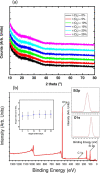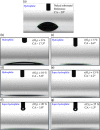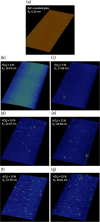Hydrophilic Antireflection and Antidust Silica Coatings
- PMID: 33681568
- PMCID: PMC7931203
- DOI: 10.1021/acsomega.0c05405
Hydrophilic Antireflection and Antidust Silica Coatings
Abstract
We report on the optical and morphological properties of silica thin layers deposited by reactive RF magnetron sputtering of a SiO2 target under different oxygen to total flow ratios [r(O2) = O2/Ar, ranging from 0 to 25%]. The refractive index (n), extinction coefficient, total transmission, and total reflectance were systematically investigated, while field-emission scanning electron microscopy, atomic force microscopy, and three-dimensional (3D) average roughness data construction measurements were carried out to probe the surface morphology. Contact angle measurements were performed to assess the hydrophilicity of our coatings as a function of the oxygen content. We performed a thorough numerical analysis using 1D-solar cell capacitance simulator (SCAPS-1D) based on the measured experimental optical properties to simulate the photovoltaic (PV) device performance, where a clear improvement in the photoconversion efficiency from 25 to 26.5% was clearly observed with respect to r(O2). Finally, a computational analysis using OptiLayer confirmed a minimum total reflectance of less than 0.4% by coupling a silica layer with n = 1.415 with another high-refractive-index (i.e., >2) oxide layer. These promising results pave the way for optimization of silica thin films as efficient antireflection and self-cleaning coatings to display better PV performance in a variety of locations including a desert environment.
© 2021 The Authors. Published by American Chemical Society.
Conflict of interest statement
The authors declare no competing financial interest.
Figures












References
-
- Jangjoy A.; Bahador H.; Heidarzadeh H. A Comparative Study of a Novel Anti-reflective Layer to Improve the Performance of a Thin-Film GaAs Solar Cell by Embedding Plasmonic Nanoparticles. Plasmonics 2020, 1–7. 10.1007/s11468-020-01297-2. - DOI
-
- Tabrizi A. A.; Pahlavan A. Efficiency improvement of a silicon-based thin-film solar cell using plasmonic silver nanoparticles and an antireflective layer. Opt. Commun. 2020, 454, 12443710.1016/j.optcom.2019.124437. - DOI
-
- Zahid M. A.; Khokhar M. Q.; Cho E.-C.; Cho Y. H.; Yi J. Impact of Anti-Reflective Coating on Silicon Solar Cell and Glass Substrate: A Brief Review. Curr. Photovoltaic Res. 2020, 8, 1–5.
-
- Ho W.-J.; Yang H.-Y.; Liu J.-J.; Lin P.-J.; Ho C.-H. Plasmonic effects of two-dimensional indium-nanoparticles embedded within SiO2 anti-reflective coating on the performance of silicon solar cells. Appl. Surf. Sci. 2020, 508, 14527510.1016/j.apsusc.2020.145275. - DOI
-
- Sarkın A. S.; Ekren N.; Sağlam Ş. A review of anti-reflection and self-cleaning coatings on photovoltaic panels. Sol. Energy 2020, 199, 63–73. 10.1016/j.solener.2020.01.084. - DOI
LinkOut - more resources
Full Text Sources
Other Literature Sources
Research Materials

